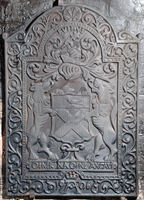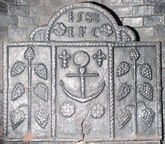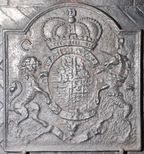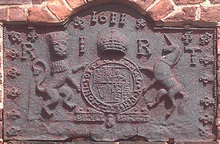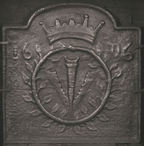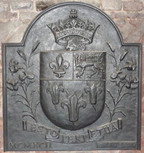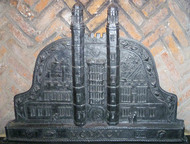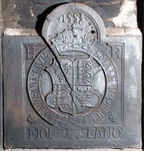-
275
Description: Arched rectangular central panel with indented arch at bottom; bead within double fillet edging; shield, helm, crest and supporters of Bruce, of Duffryn, Glamorgan; 'Fuimus' inscription above crest; motto in rectangular panel below arms; arched rectangular border with fillet edging; scrolled tendril decoration all round, except at centre bottom where is inserted crowned 'A' between halves of date; mirrored scrolls above shoulders of plate.
Notes: A modern plate in traditional style; the arms are of Henry Campbell Bruce (1851-1929), the second baron, who succeeded to the title in 1895.
Copies of this fireback are known.
Inscription: FVIMVS [We have been] / OFNER NA OFNE ANGAV [Fear him who does not fear death] / 19 A 06
Arms: Henry Campbell Bruce, 2nd Baron Aberdare
- Decoration tags:
- rectangular with round arch (shape)
- fillet (edging)
- whole carved pattern
- armorial
- text
Manufactured: in 1906 in England.
Current location: Tottington Manor, Edburton, West Sussex, England.
- Attached to series:
- British 'Dutch' style firebacks
- Personal armorial firebacks
-
276
Description: Arched rectangular shape; cavetto moulding all round; spreading oak tree, with leaves and acorns, filling the whole plate; three royal crowns, one at the top of the tree, the other two symmetrically on the ends of branches towards the top corners; initials GR towards the bottom corners, the remaining inscription on a scroll across the base.
Notes: The design is derived from the celebrated occasion when Charles II evaded his pursuers by hiding in an oak tree at Boscobel House, near Wolverhampton, following the final Royalist defeat at the battle of Worcester in 1651. This popular fireback has been copied frequently, and in this recast example the inscription has been re-modelled, with the traditional CR (for Carolus Rex) replaced by GR (for Georgius Rex - George V).
Inscription: G THE ROYALL OAK R
- Decoration tags:
- rectangular with round arch (shape)
- cavetto (edging)
- whole carved pattern
- pictorial
- royal
- text
- plants
Manufactured: in the early-20th century in England.
Current location: Chequers, Ellesborough, Buckinghamshire, England.
- Attached to series:
- Commemorative firebacks
-
281
Description: This fireback comprises at least four separate elements: the rectangular central panel has an anchor with coiled rope between two fleurs de lys, below which are two roses; the two rectangular side panels each comprise a vertical stem with six grape bunches surmounted by a smaller bunch; above, a semicircular arch contains the initials between two roses as in the central panel, with the date above; where the arch meets the central panel there is an arc across each corner; the top and sides panels are edged with simulated twisted rope.
Notes: A variant of the well-known ‘Armada’ fireback.
Copies of this fireback are known.
Inscription: 1588 / IFC
- Decoration tags:
- rectangular with round arch (shape)
- simulated rope (edging)
- carved pattern panels
- text
- plants
- objects
Manufactured: in 1588 in the Weald area of England.
Current location: Chequers, Ellesborough, Buckinghamshire, England.
- Attached to series:
- Armada series
-
282
Description: Arched rectangle; cavetto moulded edging; garter enclosing Stuart royal arms, crown, crowned lion and unicorn supporters and motto; initials in top corners.
Notes: The crown is not typically English in form, suggesting that the patternmaker may have been of foreign extraction.
Copies of this fireback are known.
Inscription: C R / [Garter motto - illeg.]
Arms: English Stuart royal
- Decoration tags:
- rectangular with round arch (shape)
- cavetto (edging)
- whole carved pattern
- armorial
- royal
- text
Manufactured: in the mid- to late-17th century in England.
Current location: Chequers, Ellesborough, Buckinghamshire, England.
-
278
Description: Arched rectangular shape with fillet edging; mirrored drapery swags emanating from two wings, and terminating in elongated tassels hung from hooks; date split by wings; initials split at bottom corners.
Notes: A simple design with space for further personalised decoration.
Copies of this fireback are known.
Inscription: 16 87 / C S
- Decoration tags:
- rectangular with round arch (shape)
- cavetto (edging)
- whole carved pattern
- individual letters
- individual numbers
- heraldic
- text
- objects
Manufactured: in 1687 possibly in the Siegerland area of Germany.
Current location: Chequers, Ellesborough, Buckinghamshire, England.
- Attached to series:
- 'Dutch' Border only firebacks
-
967
Description: Arched rectangular shape; twisted rope edging; central shield, garter, supporters, motto and crown; date in arch; initials 'I R' (Iacobus Rex) separated by crown; initials 'R T' separated by supporters, and level with other initials; fleur-de-lys stamp repeated 16 times, one each side of date, two on each shoulder of plate, five down each side.
Notes: A naively carved armorial of James I. The initials 'RT' are likely to be those of the person who commissioned the fireback. A fireback with an identical armorial, supporters and royal initials, dated 1633, was recorded by Alfred Watkins at Fawley Court, Brockhampton, Herefordshire, before 1918 (but now no longer in situ).
Inscription: 1611 / R I R T / HONY SOIT QVI MAL Y PENSE / [motto illegible]
Arms: English Stuart royal
- Decoration tags:
- rectangular with round arch (shape)
- rope (edging)
- whole carved pattern
- individual letters
- individual numbers
- heraldic
- armorial
- text
Manufactured: in 1611 in England.
Current location: 48 Scotland Street, Ellesmere, Shropshire, England.
- Attached to series:
- Stuart royal armorial firebacks
-
58
Description: Arched rectangular shape; cavetto edging; a pheon (a downward-pointing arrow head barbed on the inner edge), the badge of the Sidneys, within a wreath, an earl’s coronet above; the date on either side of the coronet.
Notes: The badge is of the Sidneys, Earls of Leicester. The date is most likely to be 1626 as the Earldom was not conferred upon Robert Sidney until 1618 and he died in 1626. A recast plate.
Inscription: 16 [?]26
Arms: Badge of Sidney family, Earls of Leicester
- Decoration tags:
- rectangular with round arch (shape)
- astragal (edging)
- whole carved pattern
- individual numbers
- heraldic
- text
Manufactured: in the early- to mid-17th century possibly at Robertsbridge Furnace, Salehurst in the Weald area of England.
Current location: Florence Court, Enniskillen, Fermanagh, Northern Ireland.
Museum number: 630836 (part of the National Trust museum group)
- Attached to series:
- Earl of Leicester series
- Personal firebacks
-
1179
Description: Arched rectangular shape; astragal and fillet edging (top and sides); central shield with arms of Eton College, surmounted by a small tilting shield of the pre-1603 Royal arms of England (France modern quartering England) aslant beneath a crown; to each side a spray of lilies; below, a scroll bearing the motto - Esto Perpetua; bottom left the date MCMXCII; bottom right, a panel bearing the phrase C of A and [?].
Notes: The motto Esto Perpetua means Let it be perpetual. Fireback designed by and made for Martin, Lord Charteris of Armisfield, who was Provost of Eton College 1978-91. One of a set of two cast for the college.
Copies of this fireback are known.
Inscription: ESTO PERPETUA / MCMXCII C of A [Charteris of Armisfield]
Arms: Eton College
- Decoration tags:
- rectangular with round arch (shape)
- astragal & fillet (edging)
- whole carved pattern
- heraldic
- armorial
- text
- plants
Manufactured: in 1992 in England.
Current location: Eton College, Eton, Berkshire, England.
Museum number: FDA-A.238:2-2013 (part of the Eton College museum group)
- Attached to series:
- Martin Charteris firebacks
- Corporate firebacks
-
1180
Description: Quasi-arched rectangular shape; parallel simulated twisted rope edging enclosing a border of lilies; pictorial representation of the facade and gatehouse towers of Eton College, between which is a clockface below crenellation; above left, two house martins flying; at ground level, ?four people (one of which is said to be Nigel Jaques, one of the masters) all standing on a plinth bearing, in the centre, the date MCMXCV between four small cartouches, of which to the left and nearest the date is a pack of playing cards; others bear the inscriptions, MCM and CofA (Charteris of Armisfield).
Notes: Designed by and made for Martin, Lord Charteris of Armisfield, Provost of Eton (1978-91).
Inscription: MCMXCV
- Decoration tags:
- rectangular with round arch (shape)
- rope (edging)
- whole carved pattern
- pictorial
- architectural
- monogram
- text
- animals
- humans
Manufactured: in 1995 in England.
Current location: Eton College, Eton, Berkshire, England.
Museum number: FDA-A.298-2013 (part of the Eton College museum group)
- Attached to series:
- Martin Charteris firebacks
-
288
Description: Arched rectangular with plain edges; arched rectangular inset with cavetto edging and armorial design in low relief: circular garter enclosing an ornate Tudor royal shield, surmounted by a crown; date inside top of arch; initials inside top corners of rectangle; a rose in each bottom corner of rectangle; inscription in a separate rectangular panel below, split by garter buckle.
Notes: The earliest dated fireback in the English style. Molland was a Devon manor belonging to the Courtenay family. Noted as having been at Wells Deanery, Somerset, in 1845; a variant without the motto, the existence of which was noted in 1840, was illustrated by Llewellin (1863). The west country source for both of these firebacks offers the possibility of an origin in those parts.
Copies of this fireback are known.
Inscription: 1553 / E R / HONV SOIT QVY MALE V PENCE / MOL LAND
Arms: Tudor royal - Edward VI
- Decoration tags:
- rectangular with round arch (shape)
- none (edging)
- whole carved pattern
- armorial
- royal
- text
Manufactured: in 1553 .
Current location: Davington Priory, Priory Road, Faversham, Kent, England.
Citation: Collier, C. V., 1897, 'Coats of Arms in Kent Churches', Archaeologia Cantiana, 22, pp. 190-1.
- Attached to series:
- Edwardian royal armorial firebacks
- Tudor royal armorial firebacks
